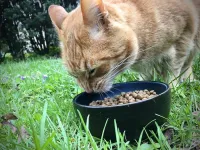(Press-News.org) URBANA, Ill. – Cat owners want Kitty to be happy, but providing an abundance of food and snacks can have unintended consequences. Feline obesity is on the rise, impacting the health, longevity, and wellbeing of cats. A new study from the University of Illinois Urbana-Champaign looks at what happens in the digestive system and gut microbiota when cats eat too much.
“About 60% of cats in the U.S. are overweight, which can lead to health problems such as diabetes and chronic inflammation. While many studies have investigated feline weight loss, there has been little focus on the opposite process, which is also important. In this study, we wanted to learn more about the metabolic and gastrointestinal changes that occur as a result of overeating and weight gain in cats,” says study co-author Kelly Swanson, professor in the Department of Animal Sciences and interim director of the Division of Nutritional Sciences (DNS), part of the College of Agricultural, Consumer and Environmental Sciences (ACES) at U. of I.
The study included 11 adult spayed female cats. They were fed a standard dry cat food and after two weeks of baseline measurements, they were allowed to eat as much as they wanted. The researchers collected blood and fecal samples at regular intervals and monitored physical activity.
Once the cats were able to overeat, they immediately increased their food intake substantially and started to gain weight. At the onset of the study, their average body condition score (BCS) was 5.41 on a 9-point scale. After 18 weeks of overfeeding, it had increased to 8.27, corresponding to being 30% overweight. BCS is equivalent to body mass index (BMI) for humans, and 6 or above is considered overweight, Swanson said.
The researchers analyzed changes in fecal output, gastrointestinal transit time, digestive efficiency (nutrient digestibility), and microbiota bacterial composition over the 20-week duration of the study.
“We found that as cats ate more and gained weight, gastrointestinal transit time was reduced, and so was digestive efficiency. When the body gets less food, it will be more efficient in extracting nutrients. But when the amount of food increases, it passes through the digestive system faster and fewer nutrients are extracted in the process,” Swanson explained.
The researchers also found significant changes in gut microbial composition between the lean cats at baseline and after 18 weeks of weight gain. The relative abundance of Bifidobacterium, which has antimicrobial activity, inhibits pathogens, and stimulates the immune system, increased, while Collinsella, which degrades fiber and has been linked to pro-inflammatory diseases, decreased. These results are opposite to what has been measured in overweight humans and suggest that their association to weight gain is complex, Swanson noted.
“The change in the gastrointestinal transit time was a novel finding and a potential reason for the change in fecal microbiota. Future studies should consider measuring transit time to better explain modifications to the microbiome of pets,” he added.
As the cats’ food consumption grew, so did their fecal output. In other words, as they ate more, they also pooped more. At the same time, fecal pH decreased, meaning that the stool became more acidic.
“In humans, a low fecal pH indicates poor absorption of carbohydrates and fat. Our findings correlate with this, as reduced fecal pH aligned with higher food intake and reduced digestibility,” Swanson said.
The researchers also measured the cats’ activity level with a monitor attached to a collar. The cats were housed in a group setting where they were able to interact with each other and play with toys, except for the days when stool samples were collected.
“We expected that weight gain might lead to decreased physical activity, but we did not observe any consistent changes in activity level. However, this could vary with individual cats and their environment, and how much their owners interact with them,” Swanson stated.
Understanding the metabolic and gastrointestinal changes that occur with weight gain and obesity in pets may help with future prevention and treatment plans, the researchers conclude.
Pet owners who want to help their cats lose weight can employ various strategies. In another new study, Swanson and his co-authors showed that restricted feeding can promote safe weight and fat loss in cats. The researchers also suggest pet parents encourage activity in their feline companions. For example, they can stimulate foraging by placing food around the home, or use food puzzles during mealtime to promote engagement and mental enrichment.
After the conclusion of the weight gain study, the 11 cats were put on a restricted-feeding diet that helped them return to normal weight.
The first study, “Effects of overfeeding on the digestive efficiency, voluntary physical activity levels, and fecal characteristics and microbiota of adult cats,” is published in the Journal of Animal Science [DOI: 10.1093/jas/skad338]. Authors are Danielle Opetz, Patricia Oba, and Kelly Swanson. Funding was provided by the USDA National Institute of Food and Agriculture (Hatch Grant #ILLU-538–937).
The second study, “Effects of weight loss and feeding specially formulated diets on the body composition, blood metabolite profiles, voluntary physical activity, and fecal metabolites and microbiota of overweight cats,” is also published in the Journal of Animal Science [DOI: 10.1093/jas/skad332]. Authors are Danielle Opetz, Patricia Oba, Darcia Kostiuk, Janelle Kelly, and Kelly Swanson. The funding for this study was provided by Champion Petfoods Holding, Inc., Edmonton, Canada.
END
What happens when cats get fat? Scientists weigh in
2023-11-01
ELSE PRESS RELEASES FROM THIS DATE:
Dr. Marlene Rabinovitch to receive the 2023 Research Achievement Award
2023-11-01
DALLAS, Nov. 1, 2023 – The American Heart Association will present its 2023 Research Achievement Award to Marlene Rabinovitch, M.D., of Stanford University. The Research Achievement Award will be recognized during the Presidential Session on Sunday, Nov. 12, 2023, at the Association’s Scientific Sessions 2023. The meeting, to be held in Philadelphia, Saturday, Nov. 11 through Monday, Nov. 13, is a premier global exchange of the latest scientific advancements, research and evidence-based clinical practice updates in cardiovascular science.
Throughout her nearly 40-year career as a physician scientist, Dr. Rabinovitch’s research ...
Dr. Yibin Wang of Duke-NUS to receive the 2023 Basic Research Prize
2023-11-01
DALLAS, Nov. 1, 2023 — The American Heart Association will present its 2023 Basic Research Prize to Yibin Wang, Ph.D., FAHA, of Duke-NUS Medical School in Singapore and Duke University School of Medicine, Durham, NC. He will be recognized during the Presidential Session of the Association’s Scientific Sessions 2023 on Sunday, Nov. 12. The meeting, to be held in Philadelphia, Saturday, Nov. 11 through Monday, Nov. 13, is a premier global exchange of the latest scientific advancements, research and evidence-based clinical practice updates in cardiovascular science.
Dr. ...
NASA’s Sandra Irish wins 2023 Society of Women Engineers Award
2023-11-01
Sandra Irish, mechanical systems lead structures engineer for NASA’s James Webb Space Telescope, has been selected to receive the Society of Women Engineers (SWE) Resnik Challenger Medal Award for her visionary contributions to the development, testing, transport, and launch of NASA’s premier space telescope since 2006. The medal was awarded during the World’s Largest Conference for Women in Engineering and Technology or WE23, which took place Oct. 26-28 in Los Angeles.
As an engineer at NASA’s Goddard Space Flight Center in Greenbelt, Maryland, for over 40 years, Irish’s mechanical systems expertise has helped ...
From soft tissue to stiff leather: Understanding the role of paxillin in liver fibrosis
2023-11-01
Currently, the United States lacks FDA-approved treatments for liver fibrosis, highlighting the critical need to understand the cellular biology and pathways associated with this condition.
In a recent study led by Don Rockey, M.D., the director of the Digestive Disease Research Core Center, and Nour Hijazi, an M.D.-Ph.D. student at the Medical University of South Carolina, significant progress has been made in understanding a pathway contributing to liver fibrosis. Their findings, highlighting a potential novel therapeutic ...
UArizona researchers examine the relationship between loneliness and being alone
2023-11-01
In a world filled with endless connections and constant communication, the relationship between loneliness and aloneness is not always clear. Now, University of Arizona researchers have analyzed that relationship – and found that they are two different things that are not closely correlated.
People don't feel lonely until they spend three-quarters of their time alone, the study found. However, when their alone time goes beyond 75%, it becomes difficult for them to avoid feelings of loneliness.
Published in the Journal of Research in Personality in September, the study also ...
Does your neighborhood affect your care after a stroke?
2023-11-01
EMBARGOED FOR RELEASE UNTIL 4 P.M. ET, WEDNESDAY, NOVEMBER 1, 2023
MINNEAPOLIS – People who live in neighborhoods with lower socioeconomic status are less likely to receive clot-busting medications or undergo clot-removing procedures after they have a stroke than people who live in neighborhoods with higher socioeconomic status, according to a study published in the November 1, 2023, online issue of Neurology®, the medical journal of the American Academy of Neurology.
“These treatments can greatly reduce death and ...
Parkinson disease and normal aging
2023-11-01
“Our principal component analyses showed a significant relationship between centro-cingulate cholinergic afferent changes and age in our Parkinson disease subjects.”
BUFFALO, NY- November 1, 2023 – A new research perspective was published in Aging (listed by MEDLINE/PubMed as "Aging (Albany NY)" and "Aging-US" by Web of Science) Volume 15, Issue 20, entitled, “Cholinergic centro-cingulate network in Parkinson disease and normal aging.”
In their new perspective, researchers Nicolaas I. Bohnen, Sygrid van der ...
Harold Hwang awarded 2024 McGroddy Prize for discovering exotic new materials
2023-11-01
The marvels of modern technology – computers that fit in your hand, internet-connected refrigerators, and self-driving cars – are only possible thanks to the magic of materials like silicon. Likewise, the sci-fi gadgets of tomorrow will spring from the exotic new materials scientists are discovering today.
Harold Hwang, a physicist at the Department of Energy's SLAC National Accelerator Laboratory and Stanford University, has brought this future closer by sandwiching carefully crafted materials together and seeing what happens where they touch. His experimentation has uncovered a host of compounds with surprising ...
University of Cincinnati study: Strawberry consumption may reduce dementia risk for middle-aged individuals
2023-11-01
New research from the University of Cincinnati found that daily strawberry consumption could help reduce the risk of dementia for certain middle-aged populations.
The research was recently published in the journal Nutrients.
Research background
In 2022, UC’s Robert Krikorian, PhD, and his team published research that found adding blueberries to the daily diets of certain middle-aged populations may lower the chances of developing late-life dementia. He said the current research into strawberries is an extension to the blueberry research.
“Both strawberries and blueberries contain antioxidants called anthocyanins, ...
November issues of American Psychiatric Association journals cover new insights in psychotic disorders, barriers to addiction treatment, bipolar disorder treatment, and more
2023-11-01
WASHINGTON, D.C., Nov. 1, 2023 — The latest issues of three American Psychiatric Association journals, The American Journal of Psychiatry, Psychiatric Services and Focus, are now available online.
The November issue of The American Journal of Psychiatry provides insights into psychotic disorders, such as the altered neurodevelopment and early symptom presentation associated with the risk of developing schizophrenia; racial and ethnic disparities in diagnosis of psychotic episodes; and predictors of first psychotic episodes and its treatment. Highlights include:
A Functional Connectome-Based Neural Signature ...




